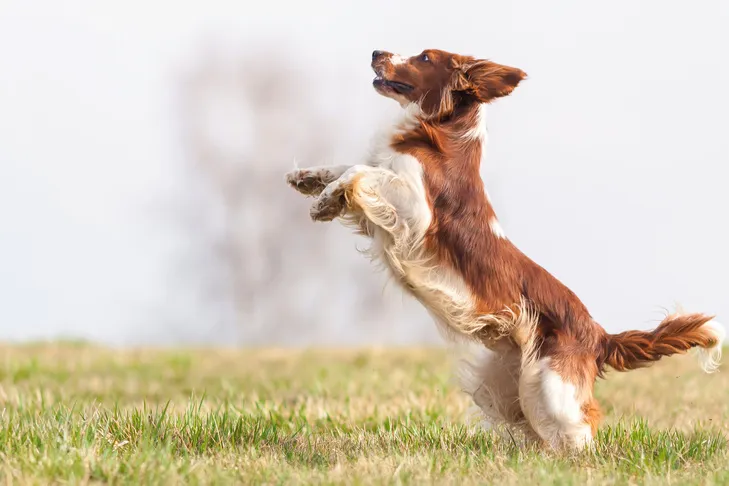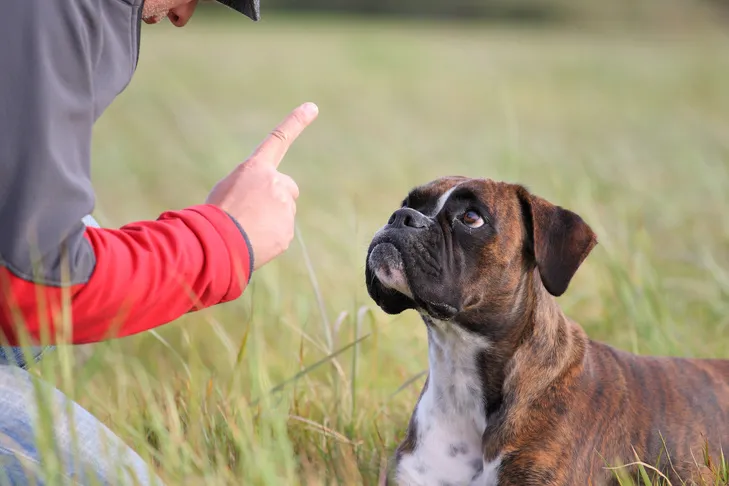Jumping up to greet people is a common and often frustrating behavior in dogs. While your canine companion is simply trying to express their excitement and say “hello” face-to-face, this behavior can be more than just annoying. Large breeds can accidentally knock over children or seniors, posing a significant safety risk. Even smaller dogs can leave scratches, muddy paw prints on clothes, or cause discomfort. The root of this behavior often lies in your dog seeking attention, and unfortunately, jumping has proven to be an effective way for them to get it. So, how do you get a dog to stop jumping when it feels like such an instinctive canine impulse?
The key is to teach your dog an alternative, more polite greeting rule, such as “keep your front paws on the floor” or a calm “sit.” This provides them with a safe and acceptable way to welcome you and earn your valuable attention. By consistently applying the following 10 expert-backed tips, you can effectively train your dog to adopt appropriate greeting behaviors. Soon, your dog will master the art of saying “hi” to humans without jumping, making every interaction a pleasant experience. If you are specifically dealing with your dog jumping on furniture, you might find additional specialized advice on how to get a dog to stop jumping on furniture.
1. Only Reward When All Four Paws are on the Floor
The most effective approach to correcting unwanted behaviors, including jumping, is to teach your dog an incompatible alternative. Dogs learn more quickly when you show them what to do, rather than just what not to do. For jumping, this means teaching your dog that greetings only happen when all four paws are firmly on the ground. They cannot jump and stand politely at the same time. Alternatively, you might teach them to sit or lie down as a greeting. Whatever your chosen rule, ensure you only provide attention, praise, or petting when your dog is following it. Consistency is paramount; avoid situations where jumping is sometimes allowed, like when you’re wearing old clothes, but forbidden at other times, like when you’re dressed up.
2. Provide Attention Immediately When Your Dog Behaves
Dogs are highly motivated by rewards, and they will naturally repeat behaviors that lead to positive outcomes. Therefore, as soon as your dog adheres to your chosen greeting rule—for example, by keeping their front paws on the floor—immediately offer praise and gentle petting. Your dog craves your attention, so it’s essential to deliver this reward without delay, especially during the learning phase. If you postpone your greeting to remove your coat or shoes, your dog might become impatient and revert to jumping to get you to notice them. Swiftly acknowledging their good behavior reinforces the correct response. This immediate feedback helps your dog understand that polite greetings earn them the attention they seek.
3. Consistently Remove Attention When Jumping Occurs
Conversely, the most crucial step to stop jumping is to remove the very reward your dog is seeking: your attention. Never reinforce a behavior you wish to eliminate. If your dog jumps on you, calmly and quickly withdraw your attention. This could mean turning your back, crossing your arms, or simply walking away to another room. Your dog will soon learn that jumping actually makes you leave, having the opposite effect of what they intended. However, as soon as your dog returns to the “four on the floor” position, turn back and quietly offer praise and petting. This clear on-off switch for your attention helps your dog understand which behavior yields the desired interaction.
 Energetic Welsh Springer Spaniel mid-jump, demonstrating unwanted greeting behavior.
Energetic Welsh Springer Spaniel mid-jump, demonstrating unwanted greeting behavior.
4. Proactively Set Your Dog Up for Success
While ignoring unwanted jumping and rewarding proper greetings is effective, it can be a frustrating, trial-and-error process for your dog. You can accelerate their learning by proactively setting them up for success. Instead of waiting for them to guess the right behavior, guide them. If your rule is for them to sit, ask for a sit as soon as you enter. If it’s “four on the floor,” encourage them to remain standing calmly.
A particularly effective method to prevent jumping is to scatter treats on the floor as you approach. Most dogs find free food irresistible, and they can’t jump while simultaneously sniffing and eating treats from the ground. The key is speed: offer the food before your dog even has a chance to think about jumping. This rewards “four on the floor” with both your attention and a tasty treat. As your dog consistently understands the greeting rule, you can gradually phase out the food rewards. For more specific guidance on how to stop your dog from jumping on you, explore tactics designed to get a dog to stop jumping on you.
5. Reward All Proper Greeting Behaviors, Every Time
For your dog to learn proper greeting behavior quickly and reliably, their actions must consistently and immediately impact your attention. This means that every single time your dog follows your greeting rule, they should be rewarded. Never withhold your attention, even if you’re feeling irritated after a bout of unwanted jumping. While it might be tempting to ignore them for a moment after a prolonged jumping session, doing so will confuse your dog. Inconsistent reinforcement makes the rule unclear and significantly slows down the learning process. Your dog needs to know that “four on the floor” always earns positive attention, without exception.
6. Avoid Physical Interventions Like Grabbing or Pushing
It’s crucial to remember that your dog jumps primarily to get your attention. Even seemingly negative physical responses, such as grabbing their paws, holding them down, or pushing them away, are still forms of attention from their perspective. This means that physical intervention can inadvertently reinforce the very behavior you’re trying to eliminate, potentially leading to an increase in jumping over time. Worse still, for some dogs, especially those with a rough-and-tumble personality, physical contact can be misinterpreted as an invitation to roughhouse play. They might return with even more vigorous jumping, believing it’s all part of an exciting game with you.
 Small American Hairless Terrier actively jumping on an owner's leg, highlighting common dog jumping problems.
Small American Hairless Terrier actively jumping on an owner's leg, highlighting common dog jumping problems.
7. Steer Clear of the “Knee Up” Method
A commonly suggested but highly problematic technique involves raising your knee to block your dog’s chest when they jump. As discussed, this physical contact can be misinterpreted as attention or an invitation to a playful wrestling match by some dogs, potentially exacerbating the jumping behavior. More importantly, for most dogs, the “knee up” method can severely erode the human-canine bond by causing distrust and discomfort. Your dog is merely attempting to greet you, albeit inappropriately, and being met with what they perceive as punishment can be confusing and hurtful. In some cases, it could even cause physical injury. A breakdown in trust can lead to other behavioral challenges, such as reluctance to come when called or increased anxiety.
8. Keep Greetings Calm and Low-Key During Training
When your dog sees you, their immense joy and excitement can be overwhelming, making it incredibly difficult for them to control their natural urge to jump. Learning emotional self-control requires significant effort, especially when their instincts are telling them to leap. You can make this process easier for your dog by keeping your own greetings low-key. Dogs are highly perceptive and can read our emotions; if you are overly excited, they will mirror that energy. Instead, maintain a calm and quiet demeanor, even when praising their good behavior. Once your dog consistently demonstrates self-control, you can gradually increase your enthusiasm, bit by bit, until you can match their joy without triggering a jumping response. This measured approach helps your dog master polite greetings even during moments of high excitement. For those struggling with their furry friend jumping specifically on them, understanding how to get my dog to stop jumping on me offers targeted solutions.
9. Prevent Jumping on Guests Through Management
Your dog’s jumping behavior isn’t only reinforced by you; other family members, guests, and even strangers on the street can inadvertently encourage it if proper precautions aren’t taken. To prevent this, implement management techniques that control your dog’s access and interactions. Consider using a leash to keep your dog by your side or to prevent them from approaching visitors until they are calm. Even better, teach your dog a “place” command, sending them to a designated mat or bed, or utilize crate training by putting your dog in their crate when guests arrive. You can also use baby gates to block access to entryways, creating a physical barrier that prevents unwanted jumping during greetings.
 Calm Boxer dog lying down on a mat outdoors, demonstrating proper 'place' training for guest greetings.
Calm Boxer dog lying down on a mat outdoors, demonstrating proper 'place' training for guest greetings.
10. Educate Guests and Strangers on Your Greeting Rules
Don’t hesitate to clearly communicate your dog’s greeting rules to guests and even strangers. While your dog is still learning, politely ask people to completely ignore your dog unless you explicitly give them permission to interact. It’s often beneficial to avoid direct interactions with unfamiliar strangers until your dog has fully mastered polite greetings with friends and family who you know will cooperate with your training methods. When encountering strangers, you can use a “watch me” cue to divert your dog’s attention, or distract them with a hand touch or a favorite toy until the person has passed. Empowering others with knowledge of your training approach is vital for consistent success, ensuring your efforts to prevent your dog from jumping on people are supported. For general strategies on managing this, learning how to get your dog to not jump on people is invaluable.
Conclusion
Teaching your dog to stop jumping requires patience, consistency, and a clear understanding of canine behavior. By focusing on positive reinforcement, teaching alternative polite greetings like “four paws on the floor” or a calm “sit,” and consistently managing your dog’s environment and interactions, you can transform an excitable jumper into a well-mannered greeter. Remember that every interaction is a training opportunity, and by consistently applying these expert tips, you’ll not only curb unwanted jumping but also strengthen the bond with your beloved companion. A dog that understands how to greet appropriately is a happier, less stressed dog, and a joy for everyone they meet. Stay committed to their training, and your “Dog Care Story” will be one of success and harmonious companionship.
